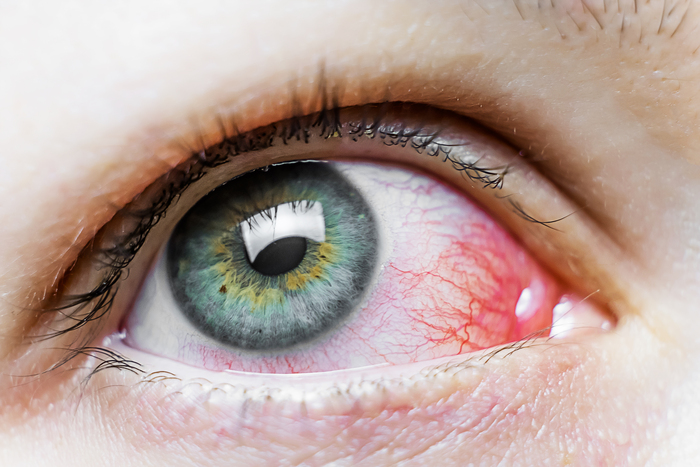
Feel better faster. Get care today.
From the clinic or your couch. Find high quality, same-day urgent care for you and your kids. Book an urgent care visit today.

Conjunctivitis, often referred to as pink eye, is an inflammation of the conjunctiva, which is the delicate membrane that lines the eyelid and covers the white part of your eyeball. This condition can arise from various causes, with viral and bacterial infections being the most common ones. It’s really important to understand the differences between viral and bacterial pink eye for effective diagnosis and treatment because each type has its own unique characteristics, symptoms, and management strategies. Read on to discover the causes, symptoms, and treatment options for both viral and bacterial pink eye conjunctivitis.
When dealing with bacterial pink eye, one of the key symptoms to watch for is a pus-like discharge that can make your eyelids feel glued together, especially after a good night’s sleep. This thick discharge, which is often yellow or green, indicates a bacterial infection and can lead to some discomfort and irritation.
On the other hand, the CDC explains that viral pink eye usually shows up with a clear, watery discharge that doesn’t contain any pus. While this kind of discharge might leave your eyes feeling teary and irritated, it doesn’t typically cause the same crusting or sticking of the eyelids. By noticing these differences in discharge, you can better identify the type of conjunctivitis and decide on the best way to take care of it.
Herpes Simplex Virus (HSV): This virus can cause a form of viral conjunctivitis, often associated with cold sores or genital herpes. It may lead to severe inflammation and discomfort in the eyes.
Adenoviruses: A common cause of viral conjunctivitis, adenoviruses are responsible for many outbreaks, especially in crowded environments like schools and daycare centers. They can also cause respiratory infections.
Coronavirus: Certain strains of the coronavirus, including those responsible for COVID-19, have been linked to conjunctivitis. This can occur as part of a broader respiratory illness or as an isolated symptom.
Enteroviruses: These viruses can also lead to viral conjunctivitis, particularly during the summer months when enteroviral infections are more prevalent.
Influenza Virus: The flu virus can contribute to conjunctivitis, often occurring alongside other flu symptoms such as fever, cough, and body aches.
Staphylococcus aureus: This bacterium is a common cause of bacterial conjunctivitis and can lead to significant eye irritation and discharge. It is often found on the skin and in the nasal passages.
Streptococcus pneumoniae: Known for causing various infections, including pneumonia and meningitis, Streptococcus pneumoniae can also lead to bacterial pink eye, particularly in children.
Haemophilus influenzae: This bacterium is another frequent cause of bacterial conjunctivitis, especially in young children. It can spread easily in settings like schools and daycare centers.
According to the CDC, there are several things you can do to help prevent contracting or spreading both viral conjunctivitis and bacterial conjunctivitis:
Wash Your Hands Often: Regular handwashing with soap and water is one of the most effective ways to prevent the spread of conjunctivitis. Be sure to wash your hands before touching your face or eyes.
Do Not Share Makeup or Towels: Avoid sharing eye makeup, brushes, and personal items like towels or washcloths, as these can harbor bacteria or viruses that cause conjunctivitis.
Throw Out Eye Cosmetics: If you suspect that your eye makeup may have been contaminated or if you have had an eye infection, it’s best to discard old eye cosmetics to prevent reinfection or spreading the infection to others.
Avoid Touching Your Eyes: Refrain from rubbing or touching your eyes, especially with unwashed hands, to minimize the risk of introducing pathogens.
Stay Home When Infected: If you or your child has conjunctivitis, it’s advisable to stay home from school or work until the infection has cleared up to prevent spreading it to others.
According to the CDC, while many cases of conjunctivitis can be cleared up at home, using eye drops recognizing when to seek medical care for pink eye is crucial for ensuring proper treatment and preventing complications. While many cases of conjunctivitis can be mild and resolve on their own, certain signs and symptoms may indicate a more serious condition that requires professional evaluation:
Symptoms Don’t Go Away After a Couple of Days: If your symptoms persist for more than a few days without improvement, it’s important to seek medical attention, as this may indicate a more serious infection.
Swollen Eyelids: If your eyelids are significantly swollen and you are having trouble opening them, this could be a sign of a severe infection that requires medical evaluation.
Fever: The presence of a fever alongside pink eye can indicate a systemic infection or a more severe case of conjunctivitis that may need medical intervention.
Severe Pain or Discomfort: If you experience intense pain in or around the eye, it may suggest a more serious condition that requires prompt medical care.
Vision Changes: Any changes in vision, such as blurriness or loss of vision, should be addressed immediately, as they may indicate complications.
Persistent Discharge: If you have a continuous, heavy discharge from the eye, especially if it is thick and pus-like, it's advisable to consult a healthcare professional for proper diagnosis and treatment.
Your doctor will likely prescribe prescription eye drops to clear up your viral conjunctivitis or bacterial conjunctivitis. Viral pink eye may not respond well to eye drops, and eye ointment may be used instead. You should avoid using contact lenses if you have pink eye.
If you're experiencing symptoms of pink eye or any other urgent health issue, don't wait to get the care you need. Use Solv to quickly find and book an appointment with a nearby urgent care provider.
Viral and bacterial pink eye, both forms of conjunctivitis, differ mainly in their symptoms and causes. Viral pink eye usually results in a clear, watery discharge and is often caused by viruses such as the herpes simplex virus, adenoviruses, certain strains of coronavirus, enteroviruses, and the influenza virus. Bacterial pink eye, on the other hand, is characterized by a pus-like discharge and is typically caused by bacteria such as Staphylococcus aureus, Streptococcus pneumoniae, and Haemophilus influenzae.
Prevention strategies include regular handwashing, not sharing makeup or towels, throwing out eye cosmetics if you suspect contamination or have had an eye infection, avoiding touching your eyes, and staying home when infected to prevent spreading the infection to others.
You should seek medical attention if your symptoms persist for more than a few days without improvement, your eyelids are significantly swollen, you have a fever, you experience severe pain or discomfort, you notice changes in vision, or you have a continuous, heavy discharge from the eye.
Treatment options for conjunctivitis often include prescription eye drops or ointments. It's important to note that viral pink eye may not respond well to eye drops, and eye ointment may be used instead. Avoid using contact lenses if you have pink eye.
Viral pink eye can be caused by a number of viruses, including the herpes simplex virus, adenoviruses, certain strains of coronavirus, enteroviruses, and the influenza virus.

From the clinic or your couch. Find high quality, same-day urgent care for you and your kids. Book an urgent care visit today.